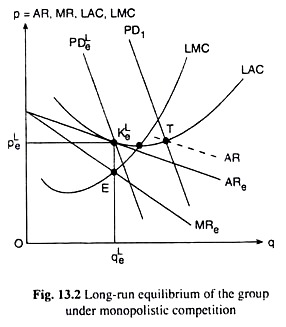ADVERTISEMENTS:
Now, as the number of firms increases in the long run, the PD curve along with the perceived demand curves shifts to the left. The process goes on till the number of firms happens to be so large that the PD curve, while shifting to left, comes to a position like PDLe and intersects the LAC curve of the firm at a point like KLe in Fig. 13.2 and, at this point, the perceived demand curve, ARe, touches the LAC curve.
At the point KLe, the number of firms is so large that each firm reaches the position of normal-profit-earning long run equilibrium.
For at this point we obtain:
(i) AR = LAC and so, this firm earns just the normal profit;
ADVERTISEMENTS:
(ii) The firm wants to sell q = qLe at p = pLe, and the firm is actually able to sell this quantity, because the (pLe, qLe) combination lies on its PD curve, viz., PDLe; and
(iii) Since TR and LTC curves (not shown in Fig. 13.2) would also touch each other at this output, we have MR = LMC at q= qLe. That is why the profit-maximising firm wants to sell q= qLe at the AR = LAC point, KLe.
It may be noted here that if the perceived demand curve, like the dotted AR curve in Fig. 13.2, does not touch the LAC curve at the point of intersection, T, between the PD curve and the LAC curve, the firm would not come to an MR = LMC position although it is at an AR = LAC position; and so the process continues till a point like KLe is obtained.
When all the firms are in long-run equilibrium at the point like KLe in Fig. 13.2. the group under monopolistic competition will also be in long-run equilibrium—since all the firms are earning just the normal profit, there would be no tendency for the new firms to join the group.
It may be noted here that if the firms under monopolistic competition happen to earn less than normal profit in the short run, then in the long run some of the existing firms would be leaving the group, and the PD curve would be shifting to the right, till the existing firms are in a position to earn the normal profit. At this point the firms and the group will be in long-run equilibrium.
